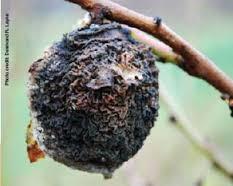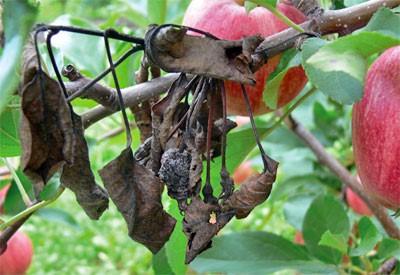
6 minute read
Prune and Fertilize Fruit
Now is the right time to lems arise. This is a moist stagnant try and scrape them off. If you want prune most fruit trees. Apples, area with little air flow. By thinning you can spray your fruit trees with plums, pears, cherries and just about the middle of your tree you will in- dormant oil labeled for fruit trees, any other tree fruit you can think of crease the air flow thus decrease in- this will smother many of the insect need a little help now before they sect and disease problems. eggs. Be sure actively start pushing out new Branches that are crossing or to read the lagrowth (wait touching should also be bel and cover and prune removed. By crossing I the branches peaches after mean they are close and limbs flowering) enough that in a few years completely. Pruning is a they will be rubbing or If your necessary pro- touching. Many times fruit trees cess that will branches will hang lower haven’t grown increase your yields, de- Tent Caterpillar Eggs when the fruit load is high and will cause wounds or as you wish or don’t seem like crease insect and disease problems, bent areas on the stems. If you think they are healthy you should have a and give you a healthy tree in the a limb will be a problem with a large soil test done. As a general rule most process. fruit load then remove it. fruit trees need ¼ pound 33-0-0 or When pruning fruit trees al- Any dried “mummy” fruit ¾ pound 10-10-10 per tree per year ways make cuts flush to the branch still hanging on the tree should be of age broadcast under the tree. Be collar, this is the raised area with a removed and composted or sure to take it out to at least the drip few wrinkles at discarded. Mummies ac- line where the feeder roots are. If the base of count for the largest insect you each branch or and disease inoculums on limb. It is im- most fruit trees. portant that you don’t If you see any canleave a stub or ker spots from fire blight cut the limb cut the limb back down flush with the trunk, meaning don’t cut the A good cut healing nicely. Notice the branch collar growing over the wound. into healthy wood, but do it soon because fire blight will be active starting in mid branch collar off. If you leave a stub March. If you are worried about it will have to rot and fall off before spreading fire blight further then dip the collar can grow over and seal off your pruning equipment in a 10% the wound. If you cut flush to the bleach solution each time you make a trunk it may never properly heal and cut. you will invite insect and disease Look for insect eggs while problems. pruning your trees. The most prevaPruning is necessarily to re- lent will be tent caterpillar. Their move damaged branches. Thin out eggs look like raised tar spots on the the tree especially in the middle stem. The egg mass is really hard where most insects and disease prob- and it’s easier to prune it out than to

Advertisement
Prune out fire blight c ankers.

Remove fruit mummies!
maintain a lawn fertilizer program your fruit trees probably don’t need fertilizing. Over fertilizing can be worse than under fertilizing because it will cause a lot of soft succulent growth, fewer flowers, and increased instance for insect and disease problems.
Winter believe it or not is a good time to prepare fruiting crops for the season ahead. It has been too cold for most of the winter for many of us to feel like braving the outdoors to any activities that aren’t absolutely essential, but on the next warm day it is very important for us to get some work done to insure a nice fruity harvest this summer. Many fruit diseases can be partially controlled by being vigilant with cleanup and fungicidal sprays at proper times. Also, remember pruning should take place in late February on fruiting trees. Below is a list of fruit crops along with diseases of concern and some things to do to help you have a successful harvest.
Apples-The diseases of concern in early spring are scab, cedar rust, and fire blight. • If you are ordering nursery stock, plan on growing diseaseresistant apples. Nursery catalogs will indicate varieties that are scabresistant. • Prune out old fire blight cankers now, while it is still cold, so new infections won't occur. • Prune also to thin the tree canopy to allow good air movement and sunlight penetration. • Remove and destroy fruit mummies left on the tree from last season. • Remove nearby cedar trees, source of rust diseases, if possible. • Obtain fixed copper or Bordeaux mixture to apply to the apple twigs and branches just as the buds begin to swell next month. • Obtain a scab fungicide with ingredients such as mancozeb, captan, myclobutanil, or thiophanate-methyl so that sprays can be applied as green foliage (green tips) is just emerging and repeated periodically throughout the spring months. Carefully read fungicide labels before making spray applications. Stone fruits-The diseases of concern in early spring are peach leaf curl, plum black knot, and eventually brown rot and scab. • Apply fixed copper or Bordeaux sprays now to prevent peach leaf curl. In some parts of the state, it may be already too late because of warm weather, buds may have begun to swell and leaf curl infections
may have just begun. • Prune to thin the tree canopy to allow good air movement and sunlight penetration. • Prune out any diseased or cankered twigs and branches from the trees. • Remove and destroy last year's mummified fruit still hanging in the tree or on the ground. • Prune out black knot disease swellings from plum trees. Obtain brown rot and scab fungicides with ingredients such as sulfur, captan, or myclobutanil. Read and understand the chemical labels. Grapes- The diseases of concern in early spring are black rot, anthracnose, cane and leaf spot, and downy mildew. • Prune the grape canopy to allow good sunlight penetration and air movement, as well as to maximize fruit production. • Prune out any diseased, dead, or cankered vines. • Remove and destroy all of last year's fruit mummies hanging on the vine and lying on the ground. • Apply lime-sulfur sprays to the dormant vines just as buds begin to swell to prevent anthracnose. • Obtain fungicides with ingredients such as captan, mancozeb, myclobutanil, or thiophanate-methyl to be used for black rot and cane and leaf spot management. Be prepared to apply fungicides as the first green leaves are beginning to appear on the vines and to repeat the applications throughout the spring as called for on the pesticide label. Brambles- The raspberry and blackberry disease of most concern in the spring are anthracnose and orange rust. • Prune out dead and winterinjured canes. • Apply lime-sulfur fungicide to the canes in early spring just as the buds begin to swell, but before green tissue emerges. • Be prepared to remove and destroy orange-rust infected blackberries and black raspberries. These plants will appear abnormally whitish and spindly in early spring as they emerge from the ground. • If orange rust is present in the neighborhood, remove and destroy wild blackberries growing in nearby fields and fencerows, if feasible.
Fireblight on Apple









